
Cetirizine
| Contato
Página Inicial

"Cheap cetirizine 5 mg line, allergy symptoms yellow jacket".
R. Will, M.B.A., M.B.B.S., M.H.S.
Vice Chair, Marian University College of Osteopathic Medicine
Internal iliac artery embolization earlier than endovascular repair of belly aortic aneurysms: frequency allergy symptoms bloody nose cetirizine 5 mg without prescription, efficacy allergy symptoms red nose generic cetirizine 10 mg amex, and medical outcomes allergy symptoms sore joints cheap cetirizine 5 mg with visa. Unilateral and bilateral hypogastric artery interruption during aortoiliac aneurysm repair in 154 patients: a relatively innocuous process quercetin allergy treatment discount cetirizine 10 mg. Internal iliac occlusion with out coil embolization during endovascular stomach aortic aneurysm restore. Endoleak as a predictor of consequence after endovascular aneurysm restore: AneuRx multicenter scientific trial. Midterm durability of abdominal aortic aneurysm endograft repair: a word of warning. Early problems and endoleaks after endovascular belly aortic aneurysm repair: report of a multicenter research. Clinical failures of endovascular stomach aortic aneurysm repair: incidence, causes, and administration. Aneurysm sac strain measurements after endovascular repair of belly aortic aneurysms. Endoleak after endovascular graft repair of experimental aortic aneurysms: does coil embolization with angiographic "seal" decrease intraaneurysmal strain. Translumbar embolization of kind 2 endoleaks after endovascular repair of belly aortic aneurysms. Type 2 endoleak embolization comparability: translumbar embolization versus modified transarterial embolization. Patency of infrarenal aortic side branches determines early aneurysm sac conduct after endovascular restore. Endovascular stentgraft in stomach aortic aneurysms: the relationship between patent vessels that come up from the aneurysmal sac and early endoleak. The endovascular repair of abdominal aortic aneurysm: an update analysis of structural failure modes of endovascular stent grafts. Lessons discovered from aortic aneurysm stent graft failure; observations from a number of perspectives. Mechanical failure of prosthetic human implants: a 10-year expertise with aortic stent graft devices. Rupture of an stomach aortic aneurysm after endovascular graft placement and aneurysm size reduction. Corroded nitinol wires in explanted aortic endografts: an necessary mechanism of failure. Final results of the Endurant Stent Graft System in the United States regulatory trial. Predicting iliac limb occlusion after bifurcated aortic stent grafting: anatomic and device-related causes. Endovascular therapy of iliac limb stenoses or occlusions in 31 sufferers treated with the Ancure endograft. Endoleak after endovascular aortic restore: classification, prognosis and management following endovascular thoracic and stomach aortic restore. Adverse consequences of inner iliac artery occlusion throughout endovascular restore of belly aortic aneurysms. Clinical end result and morphologic determinants of mural thrombus in abdominal aortic endografts. Predicting iliac limb occlusions after bifurcated aortic stent grafting: anatomic and device-related causes. Nature, frequency, and predictors of secondary procedures after endovascular restore of belly aortic aneurysm. Distal migration of stent-grafts after endovascular repair of belly aortic aneurysms. Anatomical danger elements for proximal perigraft endoleak and graft migration following endovascular repair of stomach aortic aneurysms. Device migration after endoluminal belly aortic aneurysm repair: evaluation of 113 cases with a minimum follow-up interval of two years. How is sturdiness associated to affected person selection and graft design with endoluminal grafting for abdominal aortic aneurysm. Stent-graft migration following endovascular repair of aneurysms with large proximal necks: anatomical threat factors and long-term sequalae. Concerns for the durability of the proximal abdominal aortic aneurysm endograft fixation from a 2-year and 3-year longitudinal tomography angiography research. Disparate consequence after endovascular therapy of small versus large abdominal aortic aneurysm. Need for secondary interventions after endovascular restore of belly aortic aneurysms. Life-table evaluation and assisted success following endoluminal repair of belly aortic aneurysms: the position of supplementary endovascular intervention in enhancing end result. Aortic aneurysm sac shrinkage after endovascular repair is device- dependent: a comparability of Zenith and AneuRx endografts. Abdominal aortic aneurysm size regression after endovascular restore is endograft dependent. Endovascular administration of ruptured abdominal aortic aneurysms: an 8-year single-centre experience. Collected world and single heart experience with endovascular remedy of ruptured stomach aortic aneurysms. Endovascular grafting in patients with brief proximal necks: an evaluation of short-term results. Primary endovascular restore of juxtarenal aneurysms with fenestrated endovascular grafting. Aortic aneurysm, thoracoabdominal aneurysm, juxtarenal aneurysm, fenestrated endografts, branched endografts, and endovascular aneurysm repair. Repair of thoracoabdominal aortic aneurysms with fenestrated and branched endovascular stent grafts. Fenestrated and branched stent-grafts for thoracoabdominal, pararenal and juxtarenal aortic aneurysm repair. Contemporary evaluation of descending thoracic and thoracoabdominal aneurysm restore. Fenestrated stentgrafting after earlier endovascular belly aortic aneurysm repair. Fenestrated and branched endografts for the therapy of thoracoabdominal aortic aneurysms: a scientific evaluation. Merkel Abstract the vasculitides are a bunch of rare diseases linked by the pathological consequences of vascular irritation, together with bleeding, ischemia, and infarction of downstream organs. The medical spectrum of those illnesses is wide ranging and includes a myriad of clinical and pathological findings. An method to the evaluation of suspected cases of vasculitis is printed, together with key elements of the medical historical past, physical examination, laboratory testing including autoantibody serologies, advanced imaging of the vasculature, and role of biopsies. Also reviewed are present approaches to therapy and administration of those disorders. The chapter aims to present a framework for approaching the forms of patients with suspected vasculitis physicians specializing in vascular medication are likely to encounter in a consultative apply. Keywords vasculitis; arteritis; angiogram; inflammatory; autoimmune the vasculitides are a bunch of rare illnesses linked by the pathological penalties of vascular inflammation, together with bleeding, ischemia, and infarction of downstream organs (Box 39. However, the medical spectrum of these diseases is wide ranging and features a myriad of medical and pathological findings. Not all illness phenotypes that occur within the vasculitides are because of true "vasculitis". The diseases outlined on this chapter are uncommon, and all are every thought-about "orphan" diseases, with fewer than 200,000 cases within the United States at any time. As with most uncommon diseases, few or no well-controlled medical treatment trials have been carried out for these problems. Much of the medical investigation stems from studies of affected person cohorts at large referral facilities. This article evaluations the main forms of vasculitis, discusses analysis of suspected circumstances of vasculitis, and descriptions approaches to therapy and management of these disorders. There is a concentrate on differentiating inflammatory from noninflammatory disease as it pertains to the forms of sufferers physicians specializing in vascular medicine are prone to encounter in a consultative apply (Table 39.
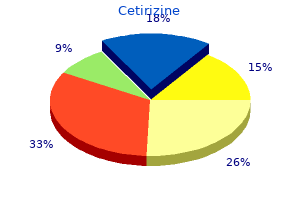
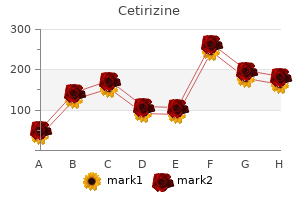
Inhibition of pyruvate dehydrogenase kinase improves pulmonary arterial hypertension in genetically susceptible sufferers allergy treatment homeopathy cetirizine 5 mg discount on-line. Oncometabolite 2hydroxyglutarate is a competitive inhibitor of alphaketoglutarate-dependent dioxygenases allergy symptoms 6 year molars proven 5 mg cetirizine. Hypoxiamediated will increase in L-2-hydroxyglutarate coordinate the metabolic response to reductive stress allergy shots gluten buy cetirizine 5 mg low price. Iron deficiency and raised hepcidin in idiopathic pulmonary arterial hypertension: scientific prevalence allergy on dogs cetirizine 5 mg buy otc, outcomes, and mechanistic insights. Iron homeostasis and pulmonary hypertension: iron deficiency results in pulmonary vascular reworking within the rat. Metabolic dysfunction in pulmonary hypertension: from fundamental science to medical follow. Dynamin-related protein 1-mediated mitochondrial mitotic fission permits hyperproliferation of vascular clean muscle cells and provides a novel therapeutic goal in pulmonary hypertension. Inhibition of mitochondrial fission prevents hypoxia-induced metabolic shift and mobile proliferation of pulmonary arterial clean muscle cells. Ischemia-induced Drp1 and Fis1-mediated mitochondrial fission and proper ventricular dysfunction in pulmonary hypertension. Sirtuin three deficiency is associated with inhibited mitochondrial perform and pulmonary arterial hypertension in rodents and humans. Uncoupling protein 2 deficiency mimics the consequences of hypoxia and endoplasmic reticulum stress on mitochondria and triggers pseudo-hypoxic pulmonary vascular reworking and pulmonary hypertension. Endothelial uncoupling protein 2 regulates mitophagy and pulmonary hypertension throughout intermittent hypoxia. Pathogenic function of calcium-sensing receptors within the growth and progression of pulmonary hypertension. Endothelial hyperpermeability in extreme pulmonary arterial hypertension: position of store-operated calcium entry. Transient receptor potential channel four encodes a vascular permeability defect and high-frequency Ca(2 +) transients in extreme pulmonary arterial hypertension. The function of Nogo and the mitochondria-endoplasmic reticulum unit in pulmonary hypertension. Role for runtrelated transcription issue 2 in proliferative and calcified vascular lesions in pulmonary arterial hypertension. Metabolic reprogramming regulates the proliferative and inflammatory phenotype of adventitial fibroblasts in pulmonary hypertension by way of the transcriptional corepressor C-terminal binding protein-1. Impaired angiogenesis and peripheral muscle microcirculation loss contribute to train intolerance in pulmonary arterial hypertension. The prognostic impression of follow-up assessments in patients with idiopathic pulmonary arterial hypertension. Automated 3D volumetry of the pulmonary arteries based on magnetic resonance angiography has potential for predicting pulmonary hypertension. Survival and prognostic elements in patients with connective tissue disease-associated pulmonary hypertension recognized by echocardiography: outcomes from a Korean nationwide registry. Three-dimensional echocardiography-based analysis of proper ventricular form in pulmonary arterial hypertension. Impaired international right ventricular longitudinal pressure predicts long-term adverse outcomes in sufferers with pulmonary arterial hypertension. Progressive proper ventricular dysfunction in patients with pulmonary arterial hypertension responding to remedy. Hyperpolarized (13)C magnetic resonance reveals early- and late-onset modifications to in vivo pyruvate metabolism in the failing heart. Enhanced [18F]fluorodeoxyglucose accumulation in the proper ventricular free wall predicts long-term prognosis of patients with pulmonary hypertension: a preliminary observational study. Survival in patients with idiopathic, familial, and anorexigen-associated pulmonary arterial hypertension within the modern management period. Predicting outcomes in pulmonary arterial hypertension primarily based on the 6minute stroll distance. Exercise testing can unmask proper ventricular dysfunction in systemic sclerosis sufferers with normal resting pulmonary artery stress. Impact of right ventricular reserve on exercise capacity and survival in sufferers with pulmonary hypertension. Exercise-uncovered pulmonary arterial hypertension and pharmacologic therapy: clinical advantages. Abnormal pulmonary artery pressure response in asymptomatic carriers of primary pulmonary hypertension gene. Validation of two predictive models for survival in pulmonary arterial hypertension. The impact of exercise coaching on the pulmonary arterial system in sufferers with pulmonary hypertension. Endothelin1 receptor antagonists in fetal growth and pulmonary arterial hypertension. A review of prostaglandin analogs within the administration of patients with pulmonary arterial hypertension. Safety and efficacy of ambrisentan for the therapy of portopulmonary hypertension. Hemodynamic results of ambrisentan-tadalafil combination therapy on progressive portopulmonary hypertension. Bosentan added to sildenafil remedy in sufferers with pulmonary arterial hypertension. Severe pulmonary arterial hypertension: remedy options and the bridge to transplantation. Enhancing insights into pulmonary vascular illness via a precision medicine strategy. Confirming the utility of those updates to scientific practice would require extra time, expertise, and analysis. Association of borderline pulmonary hypertension with mortality and hospitalization in a large patient cohort: insights from the Veterans Affairs medical assessment, reporting, and tracking program. Loss of hematopoietic filtering in asplenic patients may generate a prothrombotic setting in vascular tissue owing to elevated circulating ranges of platelets and abnormal erythrocytes. Alternatively, unfiltered, structurally irregular purple blood cells in asplenic sufferers could perform as procoagulant intermediaries owing to expression of the negatively charged phospholipid phosphatidylserine on the outer cell membrane, which interacts with thrombin (see the dialogue of hemoglobinopathy, further on). Late in the illness course, indicators and signs of decreased right-sided cardiac output-such as exertional chest ache, increased abdominal girth and decrease extremity edema, and syncope or close to syncope-may be current. A bruit auscultated over the lung fields throughout a midinspiratory breath maintain, present in as much as 30% of sufferers, displays turbulent move through partially occluded pulmonary vessels. Cardiovascular magnetic resonance previous to surgical remedy of continual thrombo-embolic pulmonary hypertension. Early randomized studies advised that medical remedy for these patients has hemodynamic and symptomatic benefits. Warfarin is mostly most well-liked because the anticoagulant of choice, given restricted experience with the newer oral anticoagulants that concentrate on thrombin or issue Xa (direct oral anticoagulants). Operative classification of thromboembolic disease determines consequence after pulmonary endarterectomy. Hematoxylin and eosin preparation of a distal pulmonary blood vessel in a affected person with sickle cell anemia reveals vascular easy muscle cell hypertrophy, intimal thickening (line), and sub-total obliteration of the vessel lumen as a end result of a plexiform lesion (arrows). Pulmonary hypertension in hemolytic problems: pulmonary vascular disease: the worldwide perspective. Interestingly, by binding to complement C5 and inhibiting the cleavage of C5 by C5 convertase, thereby decreasing erythrocyte hemolysis, eculizumab treatment resulted in a big decrease in hemolysis, N-terminal pro-brain natriuretic peptide ranges, and patient-reported dyspnea. Fibrosing mediastinitis, which is related to granulomatous illnesses similar to histoplasmosis, is an immunologically mediated response to caseous nodes. In the previous decade, pulmonary vein stenosis was reported in up to 20% of sufferers present process this procedure. However, improved know-how and enhanced consciousness amongst operators seem to have resulted in a considerable downward pattern in the frequency of this potentially devastating procedural complication, with up to date case series reporting event rates of 1% to 3%. Age-associated will increase in pulmonary artery systolic stress within the general inhabitants. Association of borderline pulmonary hypertension with mortality and hospitalization in large patient cohort: insights from the Veterans Affairs scientific evaluation, reporting, and monitoring program. Prevalence and risk elements of pulmonary hypertension in sufferers with elevated pulmonary venous pressure and preserved ejection fraction.
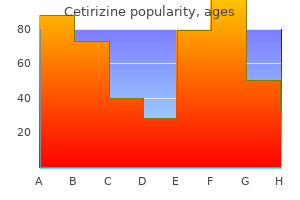
Translating evidence into follow: a decade of efforts by the American Heart Association/American Stroke Association to cut back dying and disability because of allergy forecast nh 10 mg cetirizine purchase with visa stroke: a presidential advisory from the American Heart Association/American Stroke Association allergy symptoms asthma purchase cetirizine 5 mg online. Sustained benefit of a community and professional intervention to increase acute stroke therapy allergy forecast gainesville fl cetirizine 10 mg discount online. A comprehensive evaluation of prehospital and in-hospital delay instances in acute stroke care allergy shots vacation discount cetirizine 10 mg online. Recombinant tissue type plasminogen activator (alteplase) for ischemic stroke three to 5 hours after symptom onset. Expansion of the time window for treatment of acute ischemic stroke with intravenous tissue plasminogen activator: a science advisory from the American Heart Association/American Stroke Association. Thrombectomy 6 to 24 hours after stroke with a mismatch between deficit and infarct. Treatment in a mixed acute and rehabilitation stroke unit: which elements are most important. Stroke models, tissue plasminogen activator, aspirin and neuroprotection: which stroke intervention might provide the best community profit. Multicenter comparability of processes of care between stroke models and traditional care wards in Australia. Get with the guidelines-stroke is associated with sustained improvement in care for patients with stroke or transient ischemic assault. Evidence of reperfusion harm, exacerbated by thrombolytic remedy, in human focal mind ischemia utilizing a novel imaging marker of early blood�brain barrier disruption. Effects of admission hyperglycemia on mortality and prices in acute ischemic stroke. The influence of diabetes mellitus and hyperglycaemia on stroke incidence and end result. Persistent poststroke hyperglycemia is independently related to infarct expansion and worse scientific outcome. Admission hyperglycemia predicts a worse consequence in stroke sufferers treated with intravenous thrombolysis. Admission physique temperature predicts long-term mortality after acute stroke: the Copenhagen Stroke Study. Hypothermia in animal models of acute ischaemic stroke: a systematic evaluate and meta-analysis. Endovascular cooling for reasonable hypothermia in patients with acute stroke: first outcomes of a novel approach. Prolonged reasonable hypothermia in large hemispheric infarction: medical expertise. Heads down: flat positioning improves blood move velocity in acute ischemic stroke. Early decompressive surgical procedure in malignant infarction of the center cerebral artery: a pooled analysis of three randomised controlled trials. Protocol for a randomised controlled trial of decompressive surgery in space-occupying hemispheric infarction. Blood strain lower during the acute phase of ischemic stroke is associated with mind injury and poor stroke end result. Guidelines for thrombolytic remedy for acute stroke: a supplement to the guidelines for the administration of sufferers with acute ischemic stroke. A statement for healthcare professionals from a Special Writing Group of the Stroke Council, American Heart Association. Considering the position of heparin and low molecular-weight heparins in acute ischemic stroke. Guidelines for the prevention of stroke in patients with stroke and transient ischemic attack: a suggestion for healthcare professionals from the American Heart Association/American Stroke Association. Emergency administration of abciximab for remedy of sufferers with acute ischemic stroke: outcomes of a randomized part 2 trial. Treatment of acute supratentorial ischemic stroke with abciximab is protected and may result in early neurological improvement. Definition and evaluation of transient ischemic assault: a scientific assertion for healthcare professionals from the American Heart Association/American Stroke Association Stroke Council; Council on Cardiovascular Surgery and Anesthesia; Council on Cardiovascular Radiology and Intervention; Council on Cardiovascular Nursing; and Interdisciplinary Council on Peripheral Vascular Disease. The American Academy of Neurology affirms the value of this assertion as an educational device for neurologists. Incidence and short-term prognosis of transient ischemic attack in a population-based examine. Patients with transient ischemic assault or minor stroke should be admitted to hospital. National Stroke Association guidelines for the management of transient ischemic assaults. Beneficial effects of carotid endarterectomy in symptomatic patients with high-grade carotid stenosis. Benefit of carotid endarterectomy in symptomatic patients with average and severe stenosis. Medium intensity oral anticoagulation versus aspirin after cerebral ischaemia of arterial origin. Clopidogrel and aspirin versus aspirin alone for the prevention of atherothrombotic events. Blood stress reduction and secondary prevention of stroke and different vascular events: a scientific evaluation. Randomised trial of a perindopril-based blood-pressure-lowering regimen among 6,105 people with earlier stroke or transient ischaemic attack. Guidelines for the first prevention of stroke: a suggestion for healthcare professionals from the American Heart Association/American Stroke Association. Prevention of disabling and deadly strokes by successful carotid endarterectomy in sufferers with out current neurological symptoms: randomized controlled trial. The incidence of deep and lobar intracerebral hemorrhage in whites, blacks and Hispanics. Emergency medical and surgical administration methods within the analysis and remedy of intracerebral hemorrhage. Guidelines for the management of spontaneous intracerebral hemorrhage: a suggestion for healthcare professionals from the American Heart Association/American Stroke Association. Hematoma progress and end result in treated neurocritical care sufferers with intracerebral hemorrhage related to oral anticoagulant therapy: comparability of acute remedy methods utilizing vitamin K, contemporary frozen plasma, and prothrombin complicated concentrates. Powell; Nikolaos Zacharias Abstract Carotid revascularization has been shown to lower the long-term danger of stroke compared to medical administration in appropriately selected patients. Perioperative management with antiplatelet agents, statins, and beta-blockers when indicated has been proven to improve the outcomes of carotid revascularization. Blood strain control and neurologic monitoring are the cornerstones of postoperative administration. The recent improvement of transcervical carotid artery stenting with flow reversal has added a promising therapy modality for patients with high anatomic or medical risk. In addition, hybrid procedures to deal with carotid artery stenosis have been added to the therapeutic armamentarium. This article focuses on the evidence base, medical determination making, and outcomes of the carotid revascularization strategies. Concern over recurrent stroke following the initial occasion has resulted in a push towards early revascularization within 48 hours following initiation of symptoms. Patients who current with massive infarcts on cerebral imaging, profound neurological impairment, or hemorrhage throughout the infarct should be considered for delayed revascularization between 2 and 14 days following preliminary presentation. This is very true for asymptomatic patients with important carotid stenosis the place the absolute risk reduction of stroke is decrease than that in symptomatic patients. In a potential trial, no medicines have been shown to reduce perioperative outcomes. Medications ought to be began as early as potential earlier than the surgical procedure date, and liver function tests and creatinine kinase levels monitored throughout the perioperative interval. An incision is carried out along the anterior border of the sternocleidomastoid muscle and the subcutaneous tissue and platysma muscle are divided with electrocautery. The sternocleidomastoid muscle is mobilized laterally and the fascial vein is identified and ligated. The hypoglossal nerve is rigorously mobilized if wanted and preserved cephalad to the bifurcation. To ensure a technically passable procedure, intraoperative carotid artery duplex may be carried out to confirm patency and move and exclude the presence of flaps causing hemodynamic compromise.
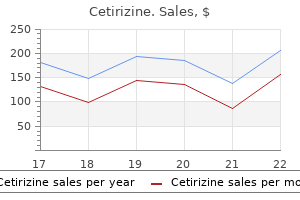
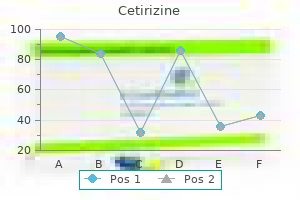
This in turn has resulted in a decline within the incidence of oslerian mycotic aneurysms in current many years allergy symptoms for cats cetirizine 5 mg purchase on-line. This may be due allergy symptoms skin rash 5 mg cetirizine purchase with visa, partially gluten allergy symptoms yahoo cetirizine 10 mg purchase visa, to the increasing age of the inhabitants and the simultaneous enhance within the prevalence of atherosclerosis allergy medicine for sore throat discount cetirizine 5 mg on-line. The bacteriology of these arterial infections is totally different from that of oslerian mycotic aneurysms. The microorganisms most commonly associated with microbial arteritis are Salmonella species, Staphylococcus species, and E. Salmonella species, specifically, have a hanging propensity for invading diseased (atherosclerotic) aortas. In chosen series, the involvement of Salmonella species has been reported to be as high as 50%. The most virulent species, Salmonella choleraesuis and Salmonella typhimurium, account for greater than 60% of the reported cases of Salmonella arteritis. Among the latter, Bacteroides fragilis has been reported in affiliation with supraceliac aortic aneurysms. The bacteriology of infected aneurysms is similar to that of each mycotic aneurysms and microbial arteritis. Although Bennett and Cherry132 reported a 66% incidence of Salmonella infections, Jarrett and associates23 described a predominance of gram-positive cocci (59%), with S. In two potential studies of patients undergoing aneurysmectomy, cultures obtained from both the aneurysm wall and the bowel bag revealed a predominance of gram-positive organisms. Patients with gram-negative micro organism demonstrated a greater likelihood of aortic rupture than did those with grampositive organisms. Specifically the rupture fee related to gram-negative bacterial, isolates was 84%, whereas that related to gram-positive bacterial cultures was 10%. According to Brown and associates,128 the most common infected aneurysms since 1965 are those that happen because of mechanical arterial damage with contamination of the vessel wall. Reddy and associates,134 in a series of infected femoral false aneurysms, reported a 65% incidence of S. Although arterial infections secondary to contiguous spread are most commonly bacterial, mycobacterial and fungal infections may occur in these lesions. Patients with cancer, extended steroid use, transplantation, and other immunosuppressive circumstances might current with infections. Specifically noted are infections from Campylobacter species, Listeria species, and Mycobacterium tuberculosis. True oslerian mycotic aneurysms most frequently involve the bigger muscular and elastic arteries. The predisposition for aortic involvement is believed to be associated to the higher incidence of underlying atherosclerotic aneurysms on this location in contrast with different anatomic sites. As one would anticipate, the arteries mostly involved are the ones that demonstrate advanced atherosclerotic changes-namely the distal aorta and the femoral, iliac, and popliteal vessels. It is curious that all sequence within the literature reveal a strong propensity for involvement of the abdominal aorta. Certainly, aortic aneurysms have been subjected to nearer scrutiny than have other peripheral arterial aneurysms. Arterial infections as a outcome of mechanical harm with contamination mostly contain arteries which have minimal soft tissue protection. There are three primary causes: accidental drug injection, vascular entry, and trauma. Because these causes are associated to the accessibility of the arteries and their superficial areas, these infections mostly involve the femoral or brachial arteries. These places also have an important effect on the presentation of those lesions, as a result of femoral and brachial artery aneurysms are usually recognized by the pulsatile mass, erythema, and tenderness of the aneurysm itself quite than by symptoms of arterial sepsis. Clinical Presentation the most typical scientific presentation in patients with primary arterial infection is fever, leukocytosis, and tenderness over the affected artery Patients may have a large. Most components of the scientific presentation can be assigned to certainly one of two general teams: signs and symptoms ensuing from infection or bacteremia, and indicators and signs occurring secondary to native arterial involvement or aneurysm formation. Night sweats, general malaise, arthralgias, and elevated fatigability along side fever and leukocytosis occur as a consequence of the recurrent bacteremias related to sepsis from the arterial infections. In sufferers with oslerian mycotic aneurysms, the clinical indicators and signs of bacterial endocarditis may be tough to distinguish from these associated with the arterial an infection. Similarly symptoms in patients with arterial lesions that developed by spread, from a contiguous suppurative source could derive from both infectious focus. The second group of signs and signs happens because of inflammation and aneurysmal dilatation of the contaminated artery Localized tenderness is essentially the most readily. Characteristics corresponding to stomach or peripheral bruits, neurologic defects from nerve compression, or pulsatile lots may be current. Thrombosis and thromboembolization are widespread sequelae of such arterial aneurysms. When they seem, they elicit related signs corresponding to ischemic digital or limb ache. Initially these embolic presentations could additionally be indistinguishable from similar, events in uninfected aneurysms. If the embolic material is contaminated and causes a secondary arterial infection, the mycotic nature of the lesion could additionally be revealed. Other findings of arterial infection embody petechial pores and skin lesions and septic arthritis. If the damaged artery is contained and supported by a capsule of fibrous connective tissue, it could progress to form a pseudoaneurysm, and the principal symptom can be ache. If the rupture is in a superficial artery that erodes through the pores and skin, the presentation is that of evident lifethreatening hemorrhage. Periarterial fuel formation alerts the presence of a gas-producing organism and must be a clear signal that urgent remedy is needed. Diagnostic Testing the diagnosis of a major arterial an infection is predicated on components of the medical presentation, along with acceptable testing. The main think about making such a diagnosis is a high medical suspicion, followed by a search for evidence to assist the analysis of a main arterial an infection. The choice and use of diagnostic tests are of singular significance in figuring out and substantiating the presence of an arterial infection. Because of the possibly fulminant course of those infections and the fatal outcome of improperly managed instances, diagnostic pace and accuracy are crucial. The fundamental parts of diagnostic testing include bacteriologic sampling and radiologic imaging. Blood Cultures the demonstration of bacterial organisms in affiliation with an arterial lesion is central to the prognosis of an arterial an infection. The bacteria may be detected by both blood cultures or cultures of the arterial wall itself. Blood cultures, by advantage of their availability, are incessantly one of the first checks carried out in patients suspected of having a major an infection. If the patient is floridly bacteremic, the blood tradition might detect the circulating micro organism. In the evaluation by Brown and associates,128 solely 60% of sufferers had constructive preoperative blood cultures. The presence of micro organism within the blood could additionally be an essential early clue to an arterial an infection, however the data from such exams must be evaluated in the correct medical context. Most bacteremic sufferers have an evident source of bacteremia that ought to be identified and handled. Patients with constructive blood cultures and no medical evidence of a concurrent an infection must be examined for attainable arterial lesions. As a outcome, in a examine of patients present process clean arterial procedures, only 2% of blood cultures had been constructive, whereas 12% of arteries and 14% of periarterial adipose tissues harbored bacteria. The kind of organism recognized in blood cultures could recommend a source of the an infection. If a blood tradition reveals Salmonella species in a affected person with an aneurysm, an arterial an infection should be seriously thought-about. Although Staphylococcus organisms are a common pathogen in arterial infections, their ubiquitous presence on pores and skin typically confuses the analysis and calls into query the results of the blood tradition. It represents the earliest reliable clue to the presence of an arterial an infection. Even within the event of a delayed end result, corresponding to when a number of days are required earlier than the blood tradition can determine the bacteria, the data provided may be invaluable in managing the affected person.
5 mg cetirizine purchase fast delivery. Pollen Allergy Symptoms - Pollen Allergy Treatment (Complete Guide to Protect Your Home from Pollen).